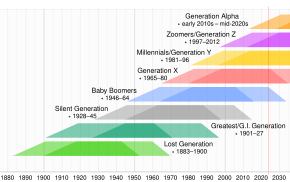| Part of a series on |
| Social generations of the Western world |
|---|
 |
Generation X (often shortened to Gen X) is the demographic cohort following the Baby Boomers and preceding Millennials. Researchers and popular media often use the mid-1960s as its starting birth years and the late 1970s as its ending birth years, with the generation being generally defined as people born from 1965 to 1980.[1][2][3][4][5] By this definition and U.S. Census data, there are 65.2 million Gen Xers[6] in the United States as of 2019.[7] Most of Generation X are the children of the Silent Generation and early Baby Boomers;[8][9] Xers are also often the parents of Millennials[8] and Generation Z.[10]
As children in the 1970s and 1980s, a time of shifting societal values, Gen Xers were sometimes called the "Latchkey Generation", which stems from their returning as children from school to an empty home and needing to use a key to let themselves in. This was a result of what is now called free-range parenting, plus increasing divorce rates, and increased maternal participation in the workforce prior to widespread availability of childcare options outside the home.
As adolescents and young adults in the 1980s and 1990s, Xers were dubbed the "MTV Generation" (a reference to the music video channel), sometimes being characterized as slackers, cynical, and disaffected. Some of the many cultural influences on Gen X youth included a proliferation of musical genres with strong social-tribal identity such as alternative rock, hip hop, punk, post-punk, rave, and heavy metal, in addition to later forms developed by Gen Xers themselves (e.g., grunge, grindcore and related genres). Film, both the birth of franchise mega-sequels and a proliferation of independent film (enabled in part by video), was also a notable cultural influence. Video games, both in amusement parlours and in devices in Western homes, were also a major part of juvenile entertainment for the first time. Politically, Generation X experienced the last days of communism in the Soviet Union and the Eastern Bloc countries of Central and Eastern Europe, witnessing the transition to capitalism in these regions during their youth. In much of the Western world, a similar time period was defined by a dominance of conservatism and free market economics.
In their midlife during the early 21st century, research describes Gen Xers as active, happy, and achieving a work–life balance. The cohort has also been more broadly credited as entrepreneurial, and productive in the workplace.
- ^ Twenge, Jean (26 January 2018). "How Are Generations Named?". Trend. The Pew Charitable Trusts. Archived from the original on 30 August 2018. Retrieved 30 November 2019.
- ^ "Distribution of Household Wealth in the U.S. since 1989". Federal Reserve Board of Governors. 14 June 2024. Retrieved 22 July 2024.
- ^ Miller, Sarah (25 August 2023). "Hate Gen X? Get in Line (Behind a Gen X-er)". New York Times. Archived from the original on 26 August 2023. Retrieved 22 July 2024.
- ^ Bump, Philip (21 August 2023). "Gen X is not the Trumpiest generation". The Washington Post. Retrieved 22 July 2024.
- ^ Hecht, Evan (2 September 2022). "What years were Gen X born? Detailed breakdown of the age range for each generation". USA Today. Retrieved 22 July 2024.
- ^ "Gen Xer". Lexico. Oxford Dictionaries. Archived from the original on 27 February 2020. Retrieved 2 December 2019.
- ^ Fry, Richard (28 April 2020). "Millennials overtake Baby Boomers as America's largest generation". Pew Research Center. Archived from the original on 28 April 2020. Retrieved 28 April 2020.
- ^ a b Strauss, William; Howe, Neil (2000). Millennials Rising: The Next Great Generation. Cartoons by R.J. Matson. New York: Vintage Original. p. 54. ISBN 978-0-375-70719-3. Retrieved 17 October 2013.
- ^ Gordinier, Jeff (27 March 2008). X Saves the World: How Generation X Got the Shaft but Can Still Keep Everything from Sucking. Viking Adult. ISBN 978-0-670-01858-1.
- ^ Williams, Alex (18 September 2015). "Move Over, Millennials, Here Comes Generation Z". The New York Times. Archived from the original on 19 September 2015. Retrieved 8 April 2016.